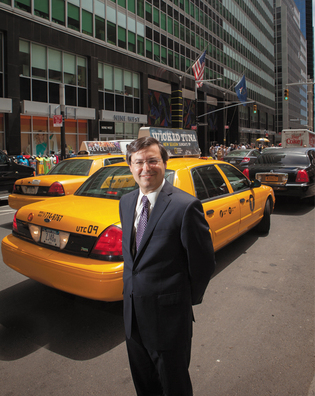 loading
loading
Where They Are NowHail to the taxi chiefWhat a taxi commissioner deals with: lawsuits, lost items, and woes of tall passengers.  Julie BrownView full imageIn 2010, David Yassky ’90JD was appointed chair of the New York City Taxi and Limousine Commission, which licenses and regulates yellow cabs and other for-hire vehicles in the city. YAM: Tell me about the “Taxi of Tomorrow,” the new design for yellow cabs. DY: This will be the first time New York has had a custom-built vehicle as a taxi. We partnered with Nissan to design the interior of the vehicle specifically for use as a cab. The legroom is greater—I’m 5' 8" or so, but we get a lot of fussing from taller passengers. It will have a panoramic roof that will give passengers a lovely view of the skyline. There will be charging points for iPads and phones, reading lights, and a “hearing loop,” which lets passengers with a hearing aid hear the driver clearly. It has a step that deploys when the back doors open, and when you open the door, a floor light illuminates so you’ll notice when your wallet or phone is on the floor. We get about 40,000 calls a year from people who left something in a cab. Starting October 31, every new taxi will be a Taxi of Tomorrow. In the next five years, we’ll see the whole fleet turn over. YAM: Why has it been so tough to get Uber, the smartphone app that hails cabs, into New York City? DY: We didn’t have rules to address how taxi drivers use e-hailing apps and wanted to get those in place. We adopted those rules in December and were ready to go into effect in February, but then the trade association that represents black-car companies [sedan services, which offer rides by appointment] sued and got a temporary restraining order. It’s a pretty aggressive industry that has some very well-funded players, and when they don’t get their way with the government, they can walk into court and sue, which they do pretty regularly. YAM: Yellow cabs are an iconic sight in Manhattan, but rare in Brooklyn, where I have to rely on sedan services whose fares seem arbitrary. DY: Mayor Bloomberg in January 2011 articulated a vision for five-borough taxi service that would bring metered taxis everywhere in the city, a fleet of vehicles that could only serve the boroughs and northern Manhattan. They’d be green instead of yellow—apple green. They were set to go into effect in June 2012, and—if the story starts to sound familiar—a few days before that was going into effect, this time the yellow-taxi fleet owners went to court and sued. That’s been in litigation ever since, but the highest court in the state of New York issues its decision by the end of May. We will win, and I do foresee those green taxis on the street in Brooklyn, Queens, the Bronx, and northern Manhattan soon. [As Yassky predicted, the state Court of Appeals upheld the plan in a June 6 ruling.] YAM: I begin to see why a law degree is useful in this line of work. DY: I use my law school training every third day, if not every day. YAM: This isn’t your first job in government. You worked in the city’s office of management and budget, you’ve run for Congress and for city comptroller, and you were on the City Council from 2001 to 2009. DY: I’m fortunate to have worked both on the legislative side and the executive side. The upside here is you get a lot more done a lot faster. Notwithstanding the impediments caused by a sometimes-recalcitrant industry, you still get a lot more results per day than you do as a legislator. The legislative timetable is years; here the timetable is months. YAM: You must talk to a lot of drivers. DY: It’s a hard job. You have to work grueling hours. You may not think of it as physically demanding, but it really is, sitting in that car for a 12-hour shift. Drivers work five shifts, commonly six shifts, and you’ll even find drivers working seven shifts a week. Last year, we did raise the fare. And we started to enforce some rules about how much fleets could charge drivers to take a car out for 12-hour shifts. When I look at the priorities over the last few years, it’s remedying service in the boroughs, upgrading the passenger experience, keeping the industry at the forefront of technology with things like e-hailing, and it’s bringing some economic fairness to the relationship between drivers and fleet owners. YAM: When you get in a cab, are you given special treatment? DY: I have yet to get into a taxi and have a driver say, “Wait, aren’t you…?”
The comment period has expired.
|
|